“Keep it tight for the first 15.”
“Test the full back early.”
“Don’t take chances early on. Keep the ball in their half.”
Team performance in different phases of a match can help inform a tactical set-up, and where teams’ strengths and weaknesses lie.
One of the features available in ProVision is a game clock, which allows an analyst to easily break-down multiple matches into different time periods.
Using data from the 2018/19 Premier League season, this blog provides some examples of how the game clock can provide an additional layer of insight into how each team typically approached the start of a game – and how their style changed if there was an opportunity to score a winning goal late on.
To press or not to press?
Pressing the opposition during the opening 15 minutes has been a tactic adopted by several leading teams during recent seasons, notably Manchester City, but if we look further down the Premier League table we can see that several teams were split as to whether or not to replicate that approach or to sit deeper and retain their shape.
The passes per defensive action (PPDA) metric, along with the average start distance of a sequence, can provide useful insights into which teams choose to press. Bottom side Huddersfield Town ranked second in allowing the fewest passes per defensive action and fourth in terms of sequences starting the closest to the opposition goal, indicating that they didn’t want the opposition to settle and have the ball.
At the other end of the scale, Wolves, Fulham, Palace, Brighton and Bournemouth sat back, as illustrated by the graphic below. The latter two of these five teams allowed their opponents more passes per defensive action than any of the other Premier League teams.
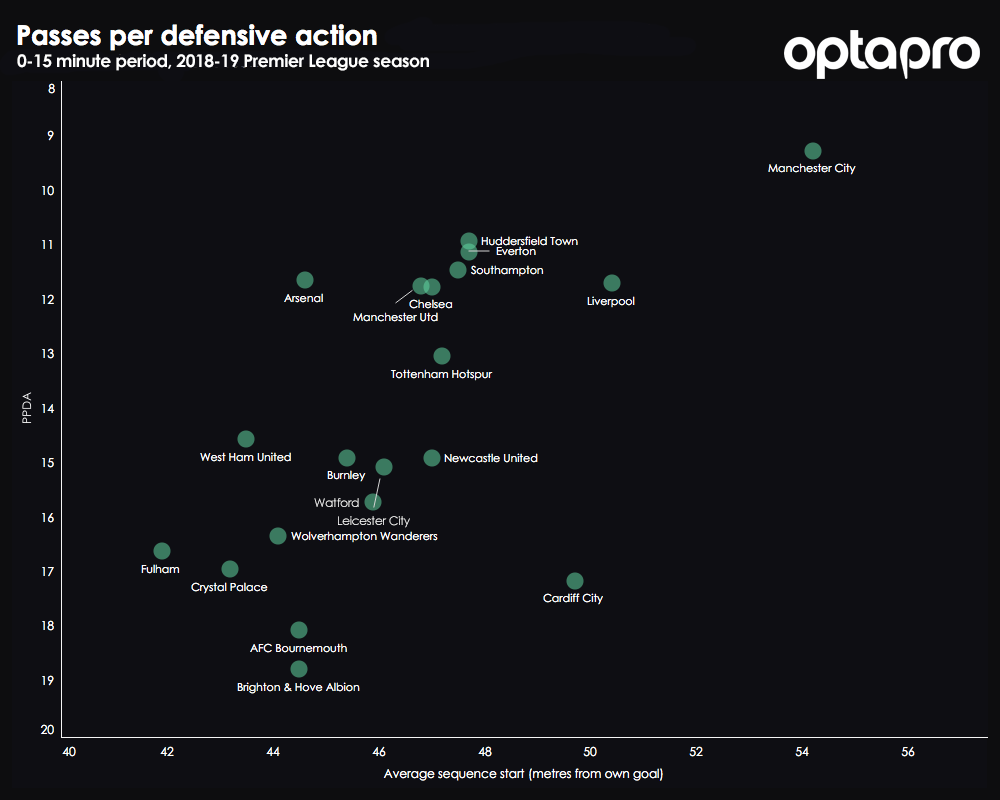
Bournemouth’s approach without the ball is noteworthy because when they won possession, they were the second fastest team in relation to getting the ball forward, countering quickly when the opposition broke down. Everton were another team who were direct when in possession, however unlike Eddie Howe’s side they adopted a similar approach to Huddersfield in relation to pressing.
Huddersfield themselves were the joint-slowest team in the league in moving the ball forward in the first 15 minutes, indicating that despite their high-pressing tendencies, they were unable to penetrate at pace.
Perhaps unsurprisingly the top six clubs enjoyed the most passes per sequence during the opening encounters, with Chelsea leading the competition with 5.1 per 90, just ahead of City. After this opening period Chelsea’s average dropped to 4.5, which reinforces how under Sarri they placed a lot of emphasis on retaining the ball early on and building-up slowly.

Which teams created the best chances?
So having established which teams looked to deny their opponents the ball and which teams looked to retain it, which teams created the best chances during the opening period?
By looking at each club’s collective xG output during the first 15 minutes, for and against, we can see that Manchester City dominated the competition in terms of chances created, whilst also giving away very few chances. Liverpool too were very strong defensively, conceding chances worth less than 0.1 xG per 90.
Despite seeing a lot of the ball, Chelsea ranked only eighth for xG, whilst Tottenham, who ranked fifth for total shots during this period, were only 10th for total xG, with the sixth lowest xG per shot ratio in the league (0.9).
City led the Premier League in total shots and xG per shot during the first 15 by some margin, with Arsenal ranking second (2.18 per 90) and third (0.15) respectively across these metrics. Bournemouth ranked second for xG per shot, so whilst they were not getting away as many shots as the big-six teams, they were creating opportunities in high quality shot locations.
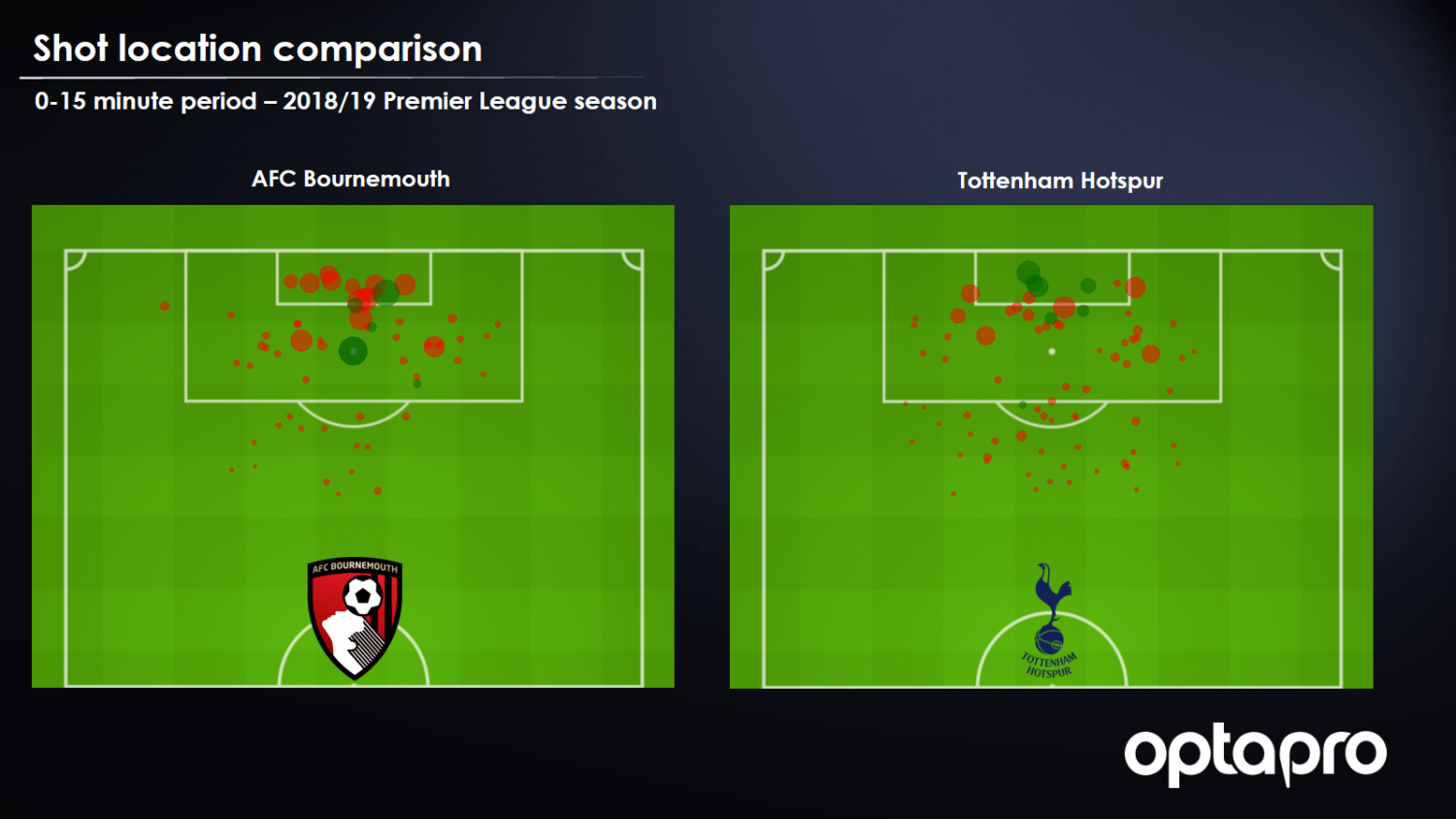
Arsenal and Bournemouth’s xG output, at both ends, suggest they were relatively open early on too. The two teams ranked second and third respectively for xG created per 90, however they both also conceded chances worth over 0.2 xG during this period.
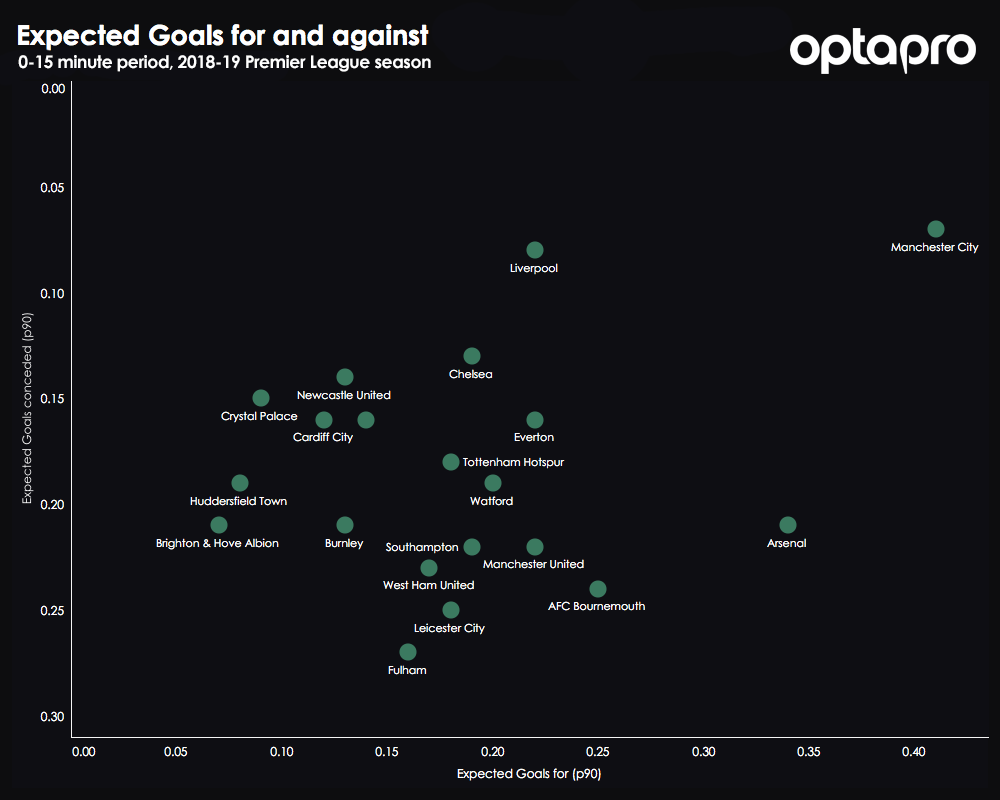
After relatively slow starts, Tottenham and Chelsea came strong towards the end of the first half, ranking second (0.15) and third (0.12) in the league for overall xG goal difference in the 15 minute period before half time.
The contrasting performance of Arsenal and Wolves
As well as being fast starters during the first half, Arsenal were also quick out of the blocks at the start of the second half, recording a positive xG goal difference during both periods. However they were unable to sustain this performance through an entire half – during the next 30 minutes of each half their goal difference dropped into negative figures.
Arsenal’s drop in performance during first half was not a result of conceding more chances – their xG conceded output remained relatively stable – instead it was because they could not sustain their high volume of high quality chances created during the first 15 minutes.
This approach contrasts strikingly with that of Wolves, who were slower starters and only created chances worth 0.14 xG during the opening period. However following that period they recorded a positive or level goal difference throughout the remaining stages of the game.
As we can see from the graph below, Nuno’s side really came to the fore during the final 15 minutes of a match, creating chances worth 0.44 xG per 90 – the second highest output in the league. So whilst they were patient early on, as indicated by their PPDA and average sequence start point during the first 15 minutes, they consistently created high quality chances late on, with João Moutinho creating 21 chances in the 75-90 minute period during the campaign worth a collective 1.24 xA.
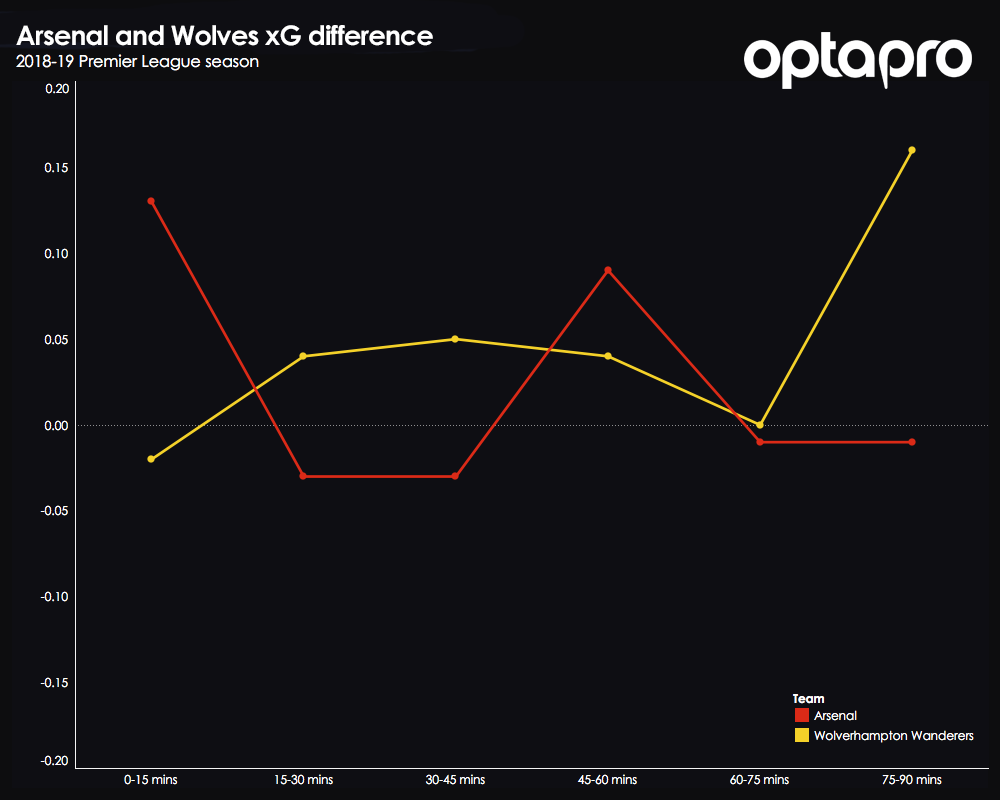
Creating clear-cut chances when pushing for a late winner
In addition to breaking down a match into separate time periods, ProVision also allows an analyst to filter data based on game state, to identify changes in the way a team plays based on whether they are winning, drawing or losing.
By focusing on the period running from the 75th minute to the final whistle when the scores are level, we can pull out some useful insights into how direct a team is as they look to push for a winning goal.
In terms of xG output per 90, Bournemouth led the competition, creating chances worth 0.49 xG during the games they played where the scores were level. They did this by tweaking their playing style as they looked to create chances.
The Cherries were more direct, both in terms of speed upfield and metres gained, and completed fewer passes per sequence than their overall season average. There was also a real emphasis on getting the ball into the box from wide positions.
Bournemouth averaged three open play crosses in the attacking third per 90 during the final 15 minutes, the second highest of any team, with a 10% increase in headed goal attempts. In comparison, they ranked 15th in the league for all open play crosses.
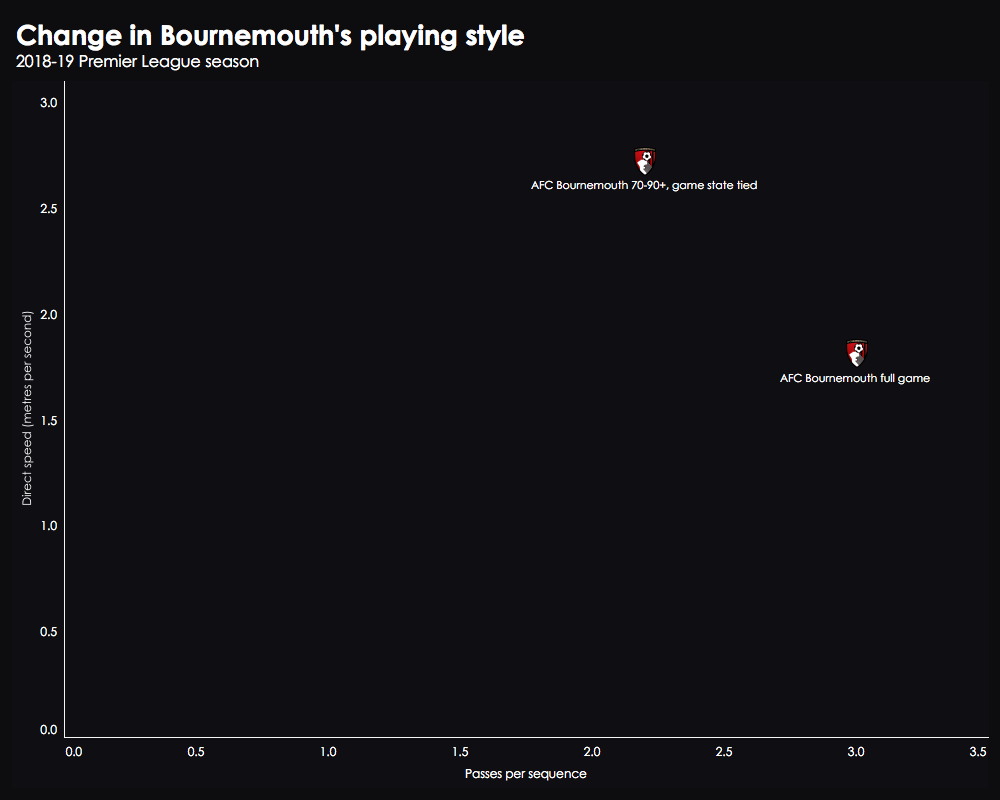
At the other end of the scale, Chelsea stood out for being the most patient team in search of a winning goal. Whilst their average sequence pass count dropped and their direct speed increased (a trend in line with most teams in the league), they averaged more sequences with a minimum of six passes and the longest sequence time. They also averaged nearly 24 passes in the attacking third – 25% more than any other team, indicating that they were willing to wait for the right opportunity to play someone in than rather than risk giving possession away.
At the other end of the pitch, Chelsea were also one of two teams not to lose a game when the scores were tied with 15 minutes to go, failing to concede a single goal during the entire season. In the closing stages of matches they conceded chances worth 0.05 xG per 90, with most attempts coming from the edge of the box or tight angles.
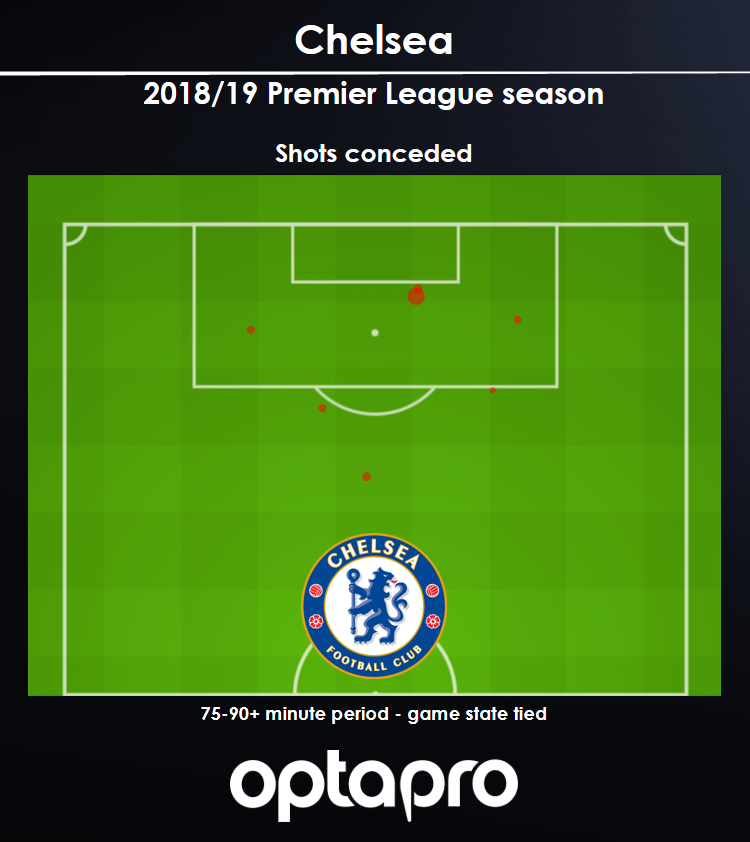
The contrasting approaches of Bournemouth and Chelsea provide an idea as to how teams adapted during the closing stages when there was an opportunity to grab a late winner, information which can potentially inform a team’s planning for potential in-game scenarios as they assess their upcoming opposition throughout the new campaign.